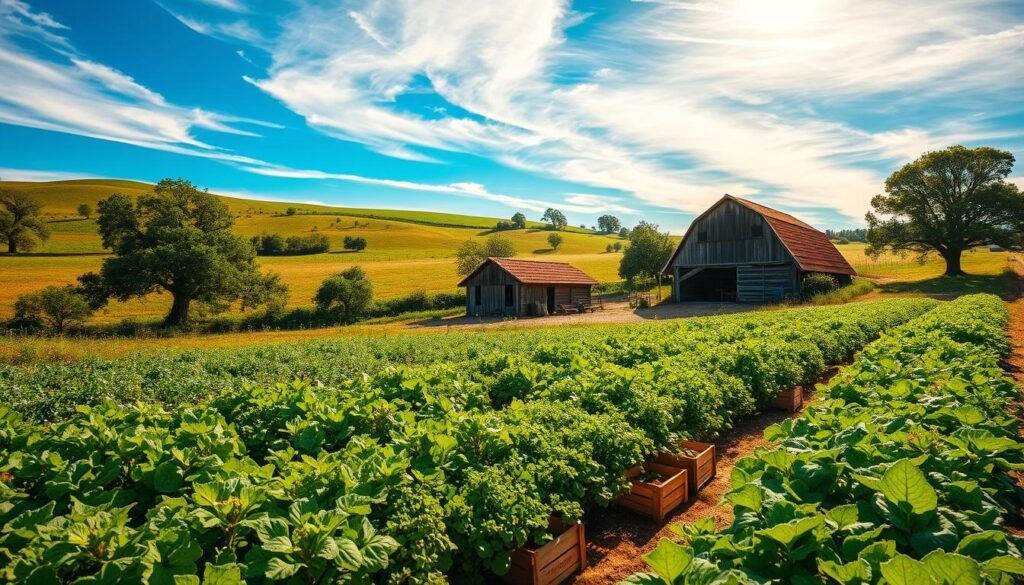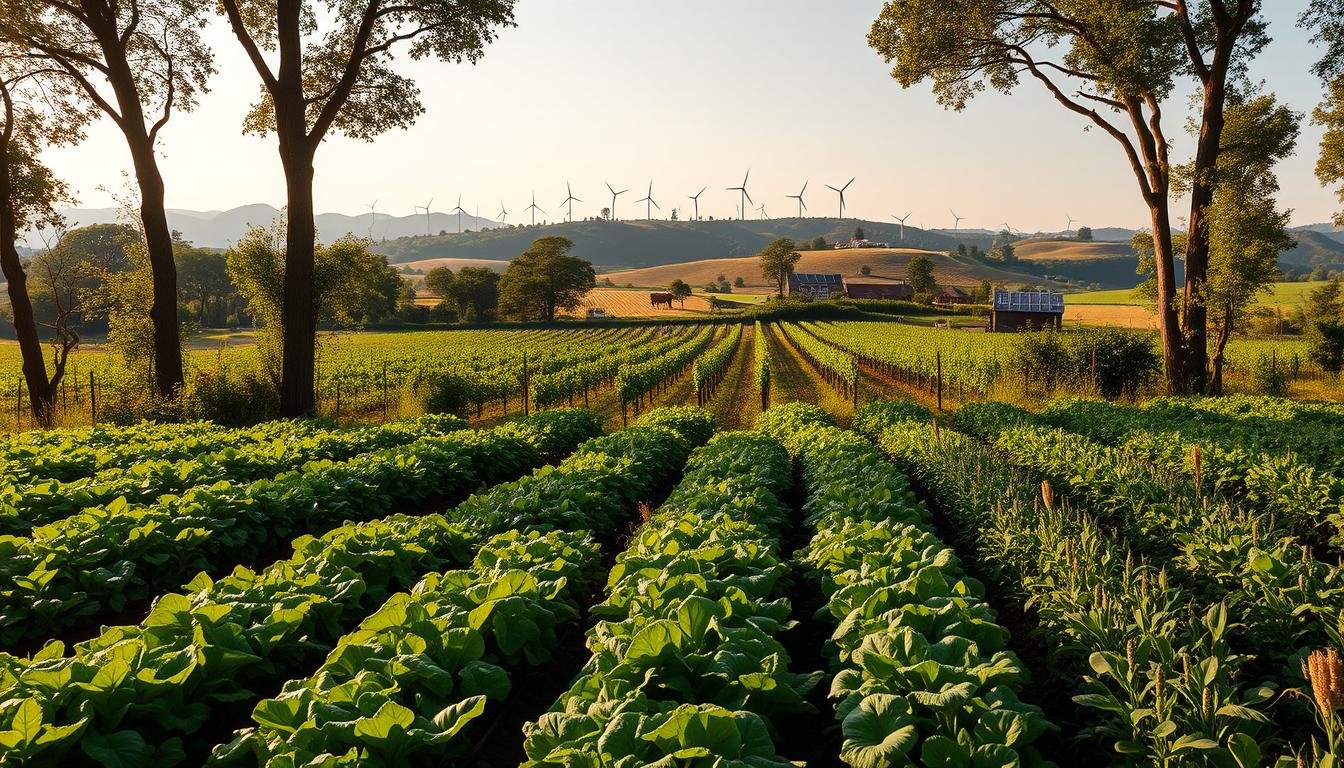Sustainable Farming: Grow Your Knowledge, Nourish the Planet
Did you know 70% of the world’s freshwater goes to farming? This shows how important it is to use water wisely and cut down on waste. Sustainable farming helps grow food without harming the planet. It uses methods like rotating crops and organic fertilizers to keep nature balanced and reduce waste.
This way of farming is key for a healthy food system for all of us in the future.
Sustainable agriculture is all about growing food without hurting the environment. By using green farming methods, we can make sure our food system stays healthy for generations to come. It’s vital for keeping our ecosystems in check and supporting sustainable farming.
Key Takeaways
- Sustainable agriculture helps minimize the negative impact on the environment.
- Efficient water use is crucial for sustainable agriculture practices.
- Sustainable farming practices promote biodiversity and reduce waste.
- Sustainable agriculture is essential for sustainable food production.
- Adopting sustainable farming practices ensures a healthy food system for future generations.
- Sustainable agriculture maintains a balanced ecosystem.
Understanding Sustainable Agriculture: Core Principles and Importance
Sustainable agriculture focuses on the health of our environment, the well-being of farmers, and the quality of our food. It’s about using regenerative practices to make soil fertile, promote biodiversity, and use water wisely. This farming method is crucial for the future of our food systems and the planet’s health.
Key principles include eco-friendly farming like natural pest control and composting. Also, biodiversity conservation through diverse crops and natural habitats. These practices help farmers reduce their environmental footprint and improve their yields.
- Improved soil health and fertility
- Increased biodiversity and ecosystem services
- More efficient water use and reduced waste
- Enhanced food quality and safety
- Support for local economies and communities
By embracing sustainable agriculture’s core principles, we can build a better food system. One that benefits both people and the planet.
| Principle | Benefits |
|---|---|
| Regenerative practices | Improved soil health, increased biodiversity |
| Eco-friendly farming | Reduced environmental impact, improved food quality |
| Biodiversity conservation | Preserved natural habitats, enhanced ecosystem services |
The Evolution of Modern Farming Practices
Modern farming has changed a lot, moving from old ways to industrial farming. Organic farming is now a big choice, focusing on being green and friendly to the earth. It uses natural ways to fight pests and diseases, not chemicals.
Agroecology is also important in farming today. It uses nature’s rules for farming. This way, farming and nature work together, helping plants and animals thrive. By using agroecology, farmers can help the planet and grow better crops.
Some good things about organic farming and agroecology are:
- Soil gets healthier and more fertile
- More plants and animals live together, helping the ecosystem
- Less pollution and helping to fight climate change
- Crops grow better and are more strong
By adopting sustainable farming practices, we can ensure a healthier and more sustainable food system for future generations.
Essential Components of Eco-Friendly Farming
Eco-friendly farming is a way to grow food that cares for the planet and people. It focuses on using methods that don’t harm the environment. This includes using climate-smart agriculture to help farmers deal with climate change.
Some key parts of eco-friendly farming are:
- Soil health management: This means using methods like crop rotation and composting to keep soil healthy.
- Water conservation techniques: This includes using water wisely, like with efficient irrigation and rainwater collection.
- Biodiversity integration: This means growing a variety of crops to help ecosystems and support beneficial insects.
- Natural pest management: This uses methods like crop rotation and biological control to fight pests and diseases.
By using these methods, farmers can help the environment while growing more food. Eco-friendly farming and climate-smart agriculture are key to a sustainable food system.
As the world’s population grows, we need to use farming that’s good for the planet and people. By choosing eco-friendly and climate-smart farming, we can make a food system that’s better for everyone.
| Component | Description |
|---|---|
| Soil Health Management | Maintaining soil fertility and structure through techniques such as crop rotation and composting |
| Water Conservation Techniques | Reducing water waste through efficient irrigation systems and conservation tillage |
| Biodiversity Integration | Promoting ecosystem services by creating habitats for beneficial insects and pollinators |
| Natural Pest Management | Managing pests and diseases through techniques such as crop rotation and biological control |
Organic Farming Methods and Certification
Organic farming is key to sustainable agriculture. It uses natural ways to keep soil healthy, save water, and support many species. It doesn’t use synthetic fertilizers, pesticides, or GMOs. This makes the environment healthier and food safer.
Important organic farming practices include crop rotation and integrated pest management. Crop rotation keeps soil fertile and structured. Integrated pest management uses natural ways to fight pests and diseases. Organic farming also values composting and natural fertilizers for soil health.
To get organic certification, farmers must follow strict rules and pass regular checks. Organic certification opens up more markets, brings higher prices, and supports a sustainable food system. As people learn more about sustainable agriculture, demand for organic products keeps rising. This supports organic farming.

Organic farming lets farmers help the environment and support sustainable agriculture. As we face more environmental issues, organic farming and sustainable agriculture will become even more crucial.
| Organic Farming Practices | Benefits |
|---|---|
| Crop Rotation | Maintains soil fertility and structure |
| Integrated Pest Management | Controls pests and diseases naturally |
| Composting and Natural Fertilizers | Promotes soil health and reduces waste |
Climate-Smart Agricultural Techniques
Farmers are now using climate-smart agriculture to face climate change. This method includes carbon sequestration, drought-resistant farming, and renewable energy. Permaculture, which aims for regenerative ecosystems, is also key in this effort.
Climate-smart agriculture offers many benefits:
- It improves crop yields and reduces losses from climate stress.
- It enhances soil health and fertility.
- It boosts biodiversity and ecosystem services.
- It cuts down greenhouse gas emissions, helping fight climate change.
By using these techniques, farmers can better handle climate change. They also help make our food system more sustainable. As the world’s population grows, focusing on climate-smart agriculture and permaculture is crucial for a food-secure future.
Permaculture can help create ecosystems that fight climate change. By supporting climate-smart agriculture and permaculture, we can build a more sustainable food system for everyone.
| Technique | Benefits |
|---|---|
| Carbon Sequestration | Improved soil health, reduced greenhouse gas emissions |
| Drought-Resistant Farming Strategies | Improved crop yields, reduced water usage |
| Renewable Energy Integration | Reduced greenhouse gas emissions, improved energy efficiency |
Implementing Permaculture Design Principles
Permaculture is a way to design sustainable living systems. It helps farmers and gardeners create diverse, resilient, and productive ecosystems. This method is similar to agroecology, which looks at how plants, animals, and their environment interact.
Zone planning is a key part of permaculture. It divides land into different zones, each with its own role. For instance, a farm might have zones for veggies, animals, and forests. This way, farmers can manage their land well, reducing waste and boosting productivity.
Benefits of Permaculture Design
- Increased biodiversity and ecosystem services
- Improved soil health and fertility
- Enhanced water conservation and management
- Increased crop yields and productivity
Agroecology and permaculture share the same goal: to work with nature. By using permaculture, farmers and gardeners can build sustainable food systems. These systems are good for people and the planet. 
Technology and Innovation in Sustainable Agriculture
Technology and innovation are changing sustainable agriculture. They help farmers use eco-friendly methods that are better for the environment. Precision agriculture, for example, uses new tech to grow more crops and waste less.
Some big changes in sustainable agriculture include:
- Vertical farming, which lets farmers grow more in less space
- Renewable energy like solar or wind power to cut down on fossil fuels
- Smart irrigation systems that save water and cut down on waste
These new ideas are good for the planet and make farms more efficient. By using sustainable methods, farmers can help the environment and make more money.
As cities grow and the world’s population increases, we need to focus on sustainable farming. Technology and innovation help us build a food system that’s good for everyone and the planet.
| Innovation | Benefits |
|---|---|
| Precision Agriculture | Optimized crop yields, reduced waste |
| Vertical Farming | Increased crop production, reduced land use |
| Reneable Energy Integration | Reduced reliance on fossil fuels, lower emissions |
Economic Viability and Market Access
The world is moving towards more sustainable practices. This means looking at the economic side of sustainable food production. It’s key to make sure sustainable farming is good for the planet and the wallet.
We need to use certifications and marketing to show the value of sustainable farming. This helps keep the environment safe and supports local businesses.
Building strong supply chains is also important. Working with farmers, distributors, and buyers helps make food production better. It’s good for the planet and helps local economies grow.
Certification and Marketing Strategies
Certifications like organic or fair trade help highlight sustainable farming. They set standards and help people choose better food. Good marketing can also boost demand for sustainable food.
Consumer Education and Engagement
Teaching people about sustainable farming is crucial. When consumers know the benefits, they’ll want more sustainable food. This supports farmers and helps the environment.
To succeed, we need a food system that’s good for the planet and local communities. By focusing on sustainable farming, conservation, and teaching consumers, we can build a better future for farming.
Conclusion: Embracing a Sustainable Agricultural Future
As we move towards a sustainable future, sustainable agriculture plays a key role. By using regenerative practices, we can feed the planet and ensure food for future generations. Eco-friendly farming, natural resource conservation, and biodiversity help us balance human needs with environmental care.
Farmers, policymakers, and consumers must join forces for change. Investing in education, research, and new technologies helps farmers use sustainable methods. This way, we can improve soil health, use water wisely, and capture carbon. Together, we can make food production and caring for the environment go together, creating a healthier planet for everyone.
FAQ
What is sustainable agriculture?
What are the three pillars of agricultural sustainability?
What are the benefits of eco-friendly farming?
What is the difference between organic farming and sustainable agriculture?
How can technology and innovation contribute to sustainable agriculture?
What is the role of consumer education and engagement in promoting sustainable food systems?
How can permaculture design principles contribute to sustainable agriculture?
Share this content:

Post Comment